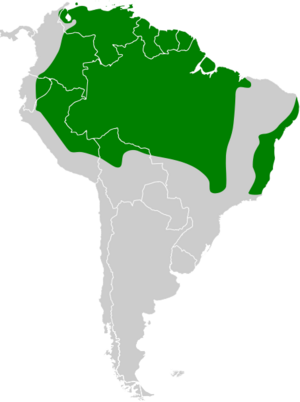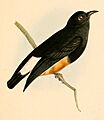Swallow-winged puffbird facts for kids
Quick facts for kids Swallow-winged puffbird |
|
|---|---|
 |
|
| Conservation status | |
| Scientific classification | |
| Genus: |
Chelidoptera
|
| Species: |
tenebrosa
|
 |
|
The swallow-winged puffbird (Chelidoptera tenebrosa) is a special kind of bird known for its unique looks. It's also called the swallow-wing. This bird lives in many countries in South America, including Bolivia, Brazil, Colombia, Ecuador, French Guiana, Guyana, Peru, Suriname, and Venezuela. It belongs to a family of birds called puffbirds, nunlets, and nunbirds.
Contents
About the Swallow-Winged Puffbird
Scientists group living things to understand them better. This is called taxonomy. The swallow-winged puffbird is the only bird in its special group, called a genus. Its scientific name is Chelidoptera tenebrosa.
There are three slightly different types, or subspecies, of this bird:
- The most common one is C. t. tenebrosa.
- Another type is C. t. brasiliensis.
- The third type is C. t. pallida.
What Does a Swallow-Winged Puffbird Look Like?
The swallow-winged puffbird is a small bird, about 14 to 15 centimeters (5.5 to 6 inches) long. It weighs between 30 and 41.5 grams (about 1 to 1.5 ounces).
The most common type, C. t. tenebrosa, has:
- Dark, sooty black feathers on its back and head. These feathers can look a bit blue in the light.
- A white lower back and rump.
- A short, black tail with white tips that wear off quickly.
- Long, pointed wings.
- A whitish chin and grayish throat.
- A sooty black chest that turns gray lower down.
- A bright orange-chestnut belly.
- A black beak, dark brown eyes, and dark gray or black feet.
The other two types have small differences:
- C. t. brasiliensis is a bit bigger. It has a white band on its belly that separates the gray chest from a more orange-yellow belly.
- C. t. pallida has lighter colors on its belly. It also has a clear white band between its gray chest and chestnut belly.
Where Do Swallow-Winged Puffbirds Live?
The swallow-winged puffbird lives across a huge area in South America. You can find it throughout the Amazon Basin, reaching the mountains in the west. It also lives in central and southeastern Brazil.
The most common type, C. t. tenebrosa, is found in:
- Most of Venezuela.
- Eastern Colombia, Ecuador, and Peru.
- Northern Bolivia.
- The Guianas (French Guiana, Guyana, Suriname).
- Much of inland Brazil, all the way to its northwestern coast.
C. t. brasiliensis lives along the southeastern coast of Brazil. This area is known as the Atlantic Forest.
C. t. pallida is only found in a small part of northwestern Venezuela.
These birds like open or partly open areas. They often prefer sandy spots with scattered bushes within forests. They can also be seen in savannas, forest edges, and along rivers. They usually live from sea level up to 1,000 meters (3,300 feet) high. Sometimes, they can be found as high as 1,750 meters (5,740 feet).
How Swallow-Winged Puffbirds Behave
Feeding Habits
The swallow-winged puffbird is a skilled hunter. It waits on an open branch or perch. When it sees a flying insect, it quickly flies out to catch it in mid-air. It eats its prey while still flying. Its diet is mostly made up of these flying insects.
Reproduction and Life Cycle
The breeding season for swallow-winged puffbirds changes depending on where they live. These birds dig a tunnel in flat, sandy ground or in an earthen bank. They even use banks made by humans, like road cuts. Inside the tunnel, the female lays one or two whitish eggs.
Vocalization
The swallow-winged puffbird has a unique voice. It sings a "twittering song" that it often makes while flying. Its calls include sounds like "'tsi-tsi-tsi'" and a clear, high "'dí-didi dí-didi dí-didi…'."
Conservation Status
The IUCN (International Union for Conservation of Nature) has looked at the swallow-winged puffbird. They have listed it as a species of "Least Concern." This means that scientists are not worried about it becoming endangered.
The bird lives across a very large area. Even though we don't know the exact number of these birds, their population seems to be growing. They are often found to be common in places where they have the right habitat. In fact, human activities like clearing forests for pastures or building roads might even help them by creating more of the open areas they like.
Images for kids
-
Chelidoptera tenebrosa illustration by Swainson, 1841



